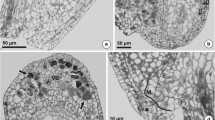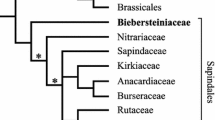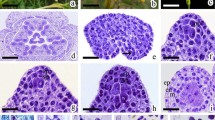Abstract
For many years several taxa belonging to the familiesCompositae andRosaceae have been subjected to an intensive research on apomixis. These two families, together with theGramineae have headed the list of the most thoroughly examined taxonomic groups in this field. At present, new methods are being elaborated and new problems solved within the following genera known to be apomictic, viz.Antennaria, Hieracium, Taraxacum, Alchemilla, Potentilla andRubus. Many general problems still require more attention in future studies. Seven of them are considered in the present article: 1. frequency of apomixis; 2. occurrence of apospory and diplospory within one taxon; 3. nonfunctional apospory; 4. facultativeness of autonomous apomixis; 5. origin of endosperm; 6. timing of embryo and endosperm development in apomicts; 7. instability of the endosperm type. BothCompositae andRosaceae produce suitable material for such research projects.
Similar content being viewed by others
References
Asker S. &Jerling L. (1992):Apomixis in plants. CRC, Boca Raton.
Battaglia E. (1945): Fenomeni citologici nuovi nella embriogenesi (“semigamia”) e nella microsporogenesi (doppionucleo di restituzione) diRudbeckia laciniata L. (nota preventiva) (New cytoembryological phenomena of embryogenesis (“semigamia”) and microsporogenesis (restitution diplonucleus) inRudbeckia laciniata L. (Preliminary report)).Nuovo Giorn. Bot. Ital. N.S. 52: 34–38.
Bremer K. (1994): Asteraceae.Cladistics and classification. Timber Press, Portland, Oregon.
Brummitt R.K. (1992):Vascular plant families and genera. Royal Botanic Gardens, Kew.
Chiarugi A. &Francini E. (1930): Apomissia inOchna serrulataWalp. (Apomixis inOchna serrulataWalp.).Nuovo Giorn. Bot. Ital. N.S. 37: 1–250.
Czapik R. (1985): Apomictic embryo sacs in diploidWaldsteinia geoidesWilld (Rosaceae).Acta Biol. Cracov., Ser. Bot. 27: 29–37.
Czapik R. (1990): Haploid parthenogenesis and polyembryony inSibbaldia procumbens L. (Rosaceae). In:Paré J. &Bugnicourt M. (eds.),Some aspects and actual orientations in plant embryology, Dedicatory volume to Prof.A. Lebeque, Moulet, Amiens, pp. 137–143.
Czapik R. (1991): Some research problems of the endosperm inAngiospermae.Polish Bot. Stud. 2: 109–120.
Davis G.L. (1966):Systematic embryology of the Angiosperms. John Willey, New York.
Davis G.L. (1967): Apomixis in theCompositae.Phytomorphology 17: 270–277.
Gustafsson Å. (1946–47): Apomixis in higher plants. Part I–III.Acta Univ. Lund., N.S., Sect. 2. 42(3): 1–67; 43(2): 71–179; 43(12): 184–370.
Hjelmqvist M. (1959): Studien über Embryologie und Variabilität bei einigenAphanes-Arten.Bot. Not. 112: 17–64.
Hohlov S.S. (1967): Apomiksis: klassifikacija i rasprostranenie u pokrytosemennych rastenij (Apomixis: classification and distribution in Angiosperms). In:Dubinin H.P. (ed.),Uspechi sovremennoj genetiki 1 (Success of the current genetics 1.), Nauka, Moskva, pp. 43–105.
Holmgren I. (1919): Zytologische Studien über die Fortpflanzung bei den GattungenErigeron undEupatorium.Kung. Svenska Vetenskapsakad. Handl. 59(7): 1–118.
Izmaiłow R. (1986): Cytoembryological studies onAlchemilla L. (seriesCalycineBuser). II. Apomictic processes in ovules.Acta Biol. Cracov., Ser. Bot. 28: 39–63.
Izmaiłow R. (1994): Embryo and endosperm relations at early stages of their development inAlchemilla subsectHeliodrosium (Rosaceae).Polish Bot. Stud. 8: 61–67.
Johri B.M., Ambegaokar K.B. &Srivastava P.S. (1992):Comparative embryology of Angiosperms 2. Springer Verlag, Berlin.
Kościńska M. (1980): Embryo and endosperm inRudbeckia bicolorNutt.Acta Biol Cracov., Ser. Bot 22: 71–79.
Kościńska-Pajak M. (1996): Embryological problems in the apomictic speciesChondrilla juncea L. (Compositae).Folia Geobot. Phytotax. 31: 397–403.
Mandrik V.Ju. (1976): Embriologične doslidžennja dejakych vydiv roduAlchemilla L. (Embryological studies in some species of the genusAlchemilla L.).Ukrains'k. Bot. Žurn. 33: 476–480.
Mandrik V.Ju. &Petrus Ju.Ju. (1985):Rosaceae. In:Batygina T.B. &Jakovlev M.S. (eds),Sravnitel'naja embriologija cvetkovych rastenij, Brunelliaceae—Tremandraceae (Comparative embryology of flowering plants, Brunelliaceae—Tremandraceae), Nauka, Leningrad, pp. 55–64.
Müntzing A. (1928): Pseudogamie in der GattungPotentilla.Hereditas 11: 267–283.
Naumova T.N. (1993):Apomixis in Angiosperms. Nucellar and integumentary embryony. CRC Press, Boca Raton.
Phipps J.B., Robertson K.R., Smith P.G. &Rohrer J.R. (1990): A checklist of the subfamilyMaloideae (Rosaceae).Canad. J. Bot. 68: 2209–2269.
Poddubnaya-Arnoldi W. (1931): Ein Versuch der Anwendung die embryologischen Methode bei der Lösung einiger systematischer Fragen.Beih. Bot. Zentralbl. 48: 141–237.
Pullaiah T. (1984): Embryology ofCompositae.Int. Biosci. Monogr. 13: 1–192.
Rutishauser A. (1954): Die Entwicklungserregung des Endosperms bei pseudogamenRanunculus-Arten.Mitt. Naturf. Ges. Schaffhausen 25: 1–45.
Rutishauser A. (1967):Fortpflanzungsmodus und Meiose apomiktischer Blütenpflanzen. Springer-Verlag, Wien, New York.
Shimotomai N. (1935): Genetische und cytologische Untersuchungen über die Pseudogamie beiPotentilla.Jap. J. Genet. 11: 297–301.
Schnarf K. (1919): Beobachtungen über die Endospermenentwicklung vonHieracium aurantiacum.Akad. Wiss. Wien Sitzungsber., Math.-Naturwiss. Kl., Abt. 1. 128: 755–771.
Solnceva M.P. (1987):Asteraceae. In:Batygina T.B. &Jakovlev M.S. (eds),Sravnitel'naja embriologija cvetkovych rastenij, Davidiaceae—Asteraceae (Comparative embryology of flowering plants Davidiaceae —Asteraceae), Nauka, Leningrad, pp. 318–331.
Author information
Authors and Affiliations
Rights and permissions
About this article
Cite this article
Czapik, R. Problems of apomictic reproduction in the FamiliesCompositae andRosaceae . Folia Geobot 31, 381–387 (1996). https://doi.org/10.1007/BF02815382
Issue Date:
DOI: https://doi.org/10.1007/BF02815382




